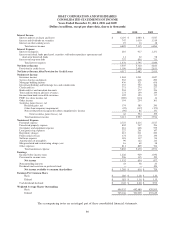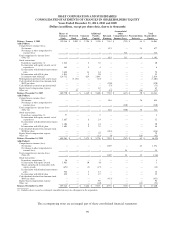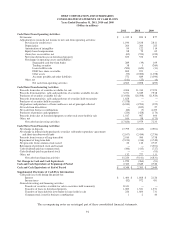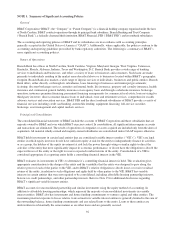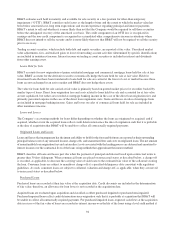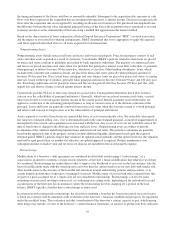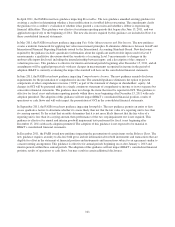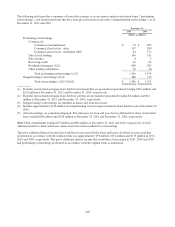BB&T 2011 Annual Report Download - page 98
Download and view the complete annual report
Please find page 98 of the 2011 BB&T annual report below. You can navigate through the pages in the report by either clicking on the pages listed below, or by using the keyword search tool below to find specific information within the annual report.the loan pools. To the extent that the expected cash flows of a loan pool have decreased since the acquisition date, BB&T
establishes an allowance for loan losses. For non-FDIC assisted purchased non-impaired loans, BB&T uses an approach
consistent with that described above for originated loans and leases.
Covered Assets and Related FDIC Loss Share Receivable
Assets subject to loss sharing agreements with the FDIC are labeled “covered” on the balance sheet and include certain
loans, securities and other assets.
The fair value of the reimbursement the Company expected to receive from the FDIC under those agreements was recorded in
the FDIC loss share receivable at the date of acquisition on the Consolidated Balance Sheets. The fair value of the FDIC loss
share receivable was estimated using a discounted cash flow methodology. The discount rate used in this calculation is
determined using a risk-free yield curve plus a premium reflecting the uncertainty related to the timing of cash flows. The
income statement effect of the changes in the FDIC loss share receivable includes the accretion due to discounting and changes
in expected reimbursements. Decreases in expected reimbursements are recognized in income prospectively consistent with the
approach taken to recognize increases in cash flows on covered loans. Increases in expected reimbursements are recognized in
income in the same period that the allowance for credit losses for the related loans is recognized.
Premises and Equipment
Premises, equipment, capital leases and leasehold improvements are stated at cost less accumulated depreciation or
amortization. Land is stated at cost. In addition, purchased software and costs of computer software developed for internal
use are capitalized provided certain criteria are met. Depreciation and amortization are computed principally using the
straight-line method over the estimated useful lives of the related assets. Leasehold improvements are amortized on a
straight-line basis over the lesser of the lease terms, including certain renewals that were deemed probable at lease
inception, or the estimated useful lives of the improvements. Capitalized leases are amortized by the same methods as
premises and equipment over the estimated useful lives or lease terms, whichever is less. Obligations under capital leases
are amortized using the interest method to allocate payments between principal reduction and interest expense. Rent
expense and rental income on operating leases is recorded using the straight-line method over the appropriate lease terms.
Securities Sold Under Repurchase Agreements
Securities sold under repurchase agreements generally have maturities ranging from 1 day to 36 months. Securities sold
under agreements to repurchase are reflected as collateralized borrowings on the Consolidated Balance Sheets and are
recorded based on the amount of cash received in connection with the borrowing. The terms of repurchase agreements
may require BB&T to provide additional collateral if the fair value of the securities underlying the borrowings declines
during the term of the agreement.
Income Taxes
Deferred income taxes have been provided when different accounting methods have been used in determining income for
income tax purposes and for financial reporting purposes. Deferred tax assets and liabilities are recognized based on future
tax consequences attributable to differences arising from the financial statement carrying values of assets and liabilities
and their tax bases. In the event of changes in the tax laws, deferred tax assets and liabilities are adjusted in the period of
the enactment of those changes, with the cumulative effects included in the current year’s income tax provision.
Derivative Financial Instruments
A derivative is a financial instrument that derives its cash flows, and therefore its value, by reference to an underlying
instrument, index or referenced interest rate. These instruments include interest rate swaps, caps, floors, collars, financial
forwards and futures contracts, swaptions, when-issued securities, foreign exchange contracts and options written and
purchased. BB&T uses derivatives primarily to manage economic risk related to securities, commercial loans, mortgage
servicing rights and mortgage banking operations, long-term debt and other funding sources. BB&T also uses derivatives
to facilitate transactions on behalf of its clients. The fair value of derivatives in a gain or loss position is included in other
assets or liabilities, respectively, on the Consolidated Balance Sheets.
BB&T classifies its derivative financial instruments as either (1) a hedge of an exposure to changes in the fair value of a
recorded asset or liability (“fair value hedge”), (2) a hedge of an exposure to changes in the cash flows of a recognized
98



